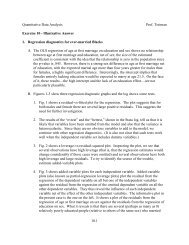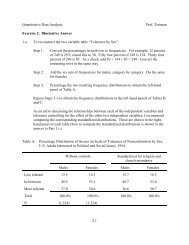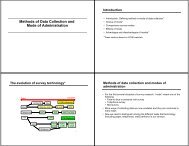Notes on Poisson Regression and Some Extensions
Notes on Poisson Regression and Some Extensions
Notes on Poisson Regression and Some Extensions
Create successful ePaper yourself
Turn your PDF publications into a flip-book with our unique Google optimized e-Paper software.
. fitstatMeasures of Fit for poiss<strong>on</strong> of childsLog-Lik Intercept Only: -2755.216 Log-Lik Full Model: -2513.219D(1489): 5026.438 LR(6): 483.994Prob > LR: 0.000McFadden’s R2: 0.088 McFadden’s Adj R2: 0.085ML (Cox-Snell) R2: 0.276 Cragg-Uhler(Nagelkerke) R2: 0.284AIC: 3.369 AIC*n: 5040.438BIC: -5858.971 BIC’: -440.131BIC used by Stata: 5077.612 AIC used by Stata: 5040.438The c<strong>on</strong>stant implies that the c<strong>on</strong>diti<strong>on</strong>al mean rate of childbearing over the life of the sampledwomen is exp(2.23) = 9.293 children. Wow! This seems large, but remember that it is adjusted upor down depending <strong>on</strong> covariates. Here is a table showing predicted rates by race, marital status,<strong>and</strong> “boomer” status evaluated at the mean level of income <strong>and</strong> educati<strong>on</strong>. This is actually based<strong>on</strong> a different model that distinguishes between those women born before 1950 <strong>and</strong> those bornbetween 1950 <strong>and</strong> 1970 (boomer).. prtab married boomer n<strong>on</strong>whtpoiss<strong>on</strong>: Predicted rates for childs--------------------------------------------| n<strong>on</strong>wht <strong>and</strong> boomer| ------ 0 ----- ------ 1 -----married | 0 1 0 1----------+---------------------------------0 | 2.0372 1.1673 2.5443 1.45791 | 2.8994 1.6614 3.6211 2.0749--------------------------------------------boomer married _Ideg_2 _Ideg_3 n<strong>on</strong>wht incomex= .60093583 .46657754 .5447861 .31149733 .22393048 10.695856The income effect is −0.028, <strong>and</strong> income is measured in $2500 increments, so a $2500 increase inincome brings about a exp(−0.028) = 0.97 change in the number of children.Exercise 4: Show that this is a 3% reducti<strong>on</strong> in the rate per $2500 increase in income. Show thatmarriage increases the rate by 47%.Zero Inflated Poiss<strong>on</strong> Data. Our data could c<strong>on</strong>tain an excess of zeros. By this we meanthat there are some zeros that would occur naturally but that the data could c<strong>on</strong>tain more zerosthan would be expected under Poiss<strong>on</strong> sampling. The excess zeros will affect the mean <strong>and</strong>variance. In particular, the mean/variance equivalence will no l<strong>on</strong>ger hold. For example, themean number of children in the U.S. is about 2 children per family. We can compare this to ourobserved distributi<strong>on</strong> (Fig. 1). However, we find that the unc<strong>on</strong>diti<strong>on</strong>al Poiss<strong>on</strong> model does notpredict the zeros as well as it predicts the other values. In this case, we may want to test thezero-inflated Poiss<strong>on</strong> model against the st<strong>and</strong>ard model.7
















